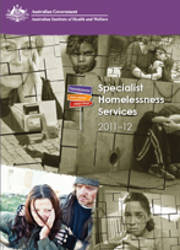Summary
Almost 230,000 Australians accessed specialist homelessness services in 2011–12
Of these clients, 44% were already homeless when they began receiving support, and 14% of these clients were living without shelter. Fifty-six per cent were at risk of homelessness when
they began receiving support. Fifty-two per cent of all clients experienced homelessness at some time during the year.
Demand for crisis accommodation remains high and a fifth of clients have an unmet need
Sixty per cent of all clients needed accommodation in 2011‒12, with 40% needing short-term or emergency accommodation. Specialist homelessness agencies provided over 7,000,000 nights of accommodation to 37% of all clients. On average, 19,128 people were accommodated each night for an average of 82 nights per client. Nearly one-fifth of clients (19%) had a need for emergency accommodation that was unmet.
Homeless males more likely to be sleeping without shelter compared to females
Males who were homeless when they began receiving support were twice as likely to be sleeping without shelter (19%) compared to homeless females (9%).
Females made up a greater proportion of clients at risk and in remote areas
Roughly equal numbers of males and females were homeless when they began receiving support, but females represented 68% of those at risk. While females represented 57% of clients in Major cities they represented 81% of clients in Very remote areas.
Domestic violence is a major cause of homelessness in Australia
One-third (34%) of clients had experienced domestic or family violence. The majority of these (78%) were female and one-fifth (21%) were less than 10 years of age.
Health and medical services are the most needed specialist services for the homeless
One-fifth of homeless clients (19%) needed health and medical services and were three times more likely to need these services than clients at risk of homelessness.
Nineteen per cent of clients were identified as having a current mental health issue
The majority of clients identified with a current mental health issue were female (56%), almost
half (48%) of clients with a current mental health issue were aged between 25 and 44.
Improvements were achieved for many clients
Overall, 18% of those sleeping rough, 26% of those living in temporary supported accommodation, and 22% of those living in a house or flat (sharing and living without tenure) were assisted into public, community or private housing with improved tenure.
Preliminary material: Acknowledgments; Abbreviations; Symbols
1 Introduction
- The policy framework for reducing homelessness
- About the Specialist Homelessness Services Collection
- About this report
2 A profile of clients
- Characteristics of clients
- Clients’ needs for assistance and services provided
- Client outcomes following support
3 A comparison of homeless and at risk clients
4 A profile of special interest groups
- Children and young clients
- Older clients
- Indigenous clients
- Families
- Clients who have experienced domestic and family violence
- Clients with a current mental health issue
- Clients leaving care
- Clients exiting custodial arrangements
- Children with a care or protection order
5 A profile of specialist homelessness agencies
- Agency size
- Agency location
6 Unmet demand
- Unassisted requests for assistance
- Unmet need for services for clients
7 Trends in the homelessness services client population
- Agencies
- Clients
Appendixes
Appendix A: About the Specialist Homelessness Services Collection and data presented in this report
Appendix B: Data quality statement: Specialist Homelessness Services Collection, 2011–12
Appendix C: Imputation strategy for the Specialist Homelessness Services Collection, 2011‒12
Appendix D: How do the SAAP NDC and the SHSC differ?
End matter: References; List of tables; List of figures; Related publications



